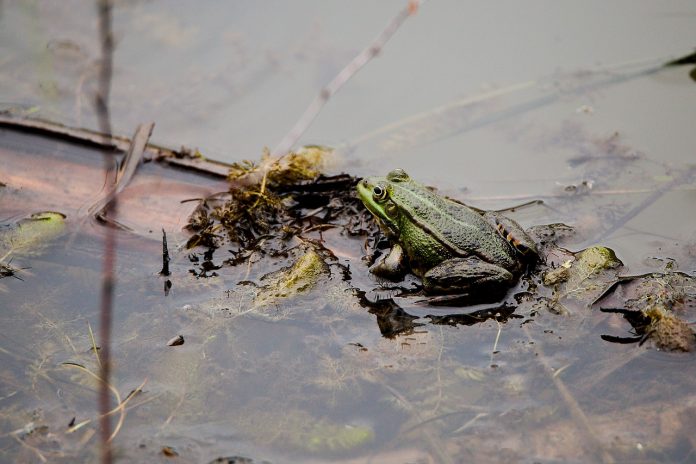If late winter cabin fever has you down, wander the woods in search of vernal pools — small bodies of water that collect in depressions in the ground.
Melting snow and late winter rains fill these shallow depressions, which can be as small as a plastic swimming pool or as large as an acre.
But they must be shallow, and they must, at some point in late spring or summer, dry up completely.
Vernal pools are about to explode with life.
As days get longer and daytime temperatures flirt with the 50s (just about when we set our clocks to spring forward an hour), aquatic invertebrates that have been dormant for months and amphibians waking from hibernation return to their birth ponds to reproduce.
Eggs of aquatic insects and crustaceans hatch to form the base of water-based food chains.
In February, wood frogs, whose bodies had been literally frozen all winter long, found their way to snow-ringed pools.
These are small brown frogs marked by a raccoon-like facial mask. Males sing their duck-like calls to attract females.
By mid-March, male spring peepers serenade females to entice them to the pools. I’ve already heard some peepers on recent warm evenings.
In April, American toads will trill their high-pitched song of life at the water’s edge. Sometimes they use puddles as small as a car floor mat.
Hidden life
The most impressive visitors to vernal pools, however, are never heard and seldom seen.
Spotted salamanders spend most of their lives in underground burrows, but on rainy late winter nights they surface and return to their natal pools to breed.
The rain allows the salamanders to stay moist during their brief time above ground.
At times, spotted salamanders can number in the hundreds or even thousands as they cross roads that separate their terrestrial habitat from vernal breeding pools.
Spotted salamanders are easily recognized. They are dark with two rows of yellow spots running the length of the body and can reach a length of eight inches.
To find spotted salamanders, get outside on rainy, late winter nights.
After locating a breeding pool, return after dark during a light drizzle when the temperature is above 40 degrees. Scan the pool with a bright flashlight. Males arrive at pools hours or even days before females.
When the females arrive, they “dance.” Males and females swim in circles and rub against each other.
Eventually, males deposit a spermatophore (a packet of sperm) on a piece of vegetation.
A female then picks up the spermatophore with her cloacal lips, and eggs are fertilized as they pass through the cloaca.
As many as 200 eggs form a gelatinous mass that can be as large as a baseball. The eggs hatch in 30 to 60 days, depending on temperature.
The carnivorous larval salamanders live for two to four months before transforming into adults. They then return to their terrestrial subterranean homes.
As larva, these salamanders eat a variety of aquatic invertebrates. The value of vernal pools to breeding amphibians is clear.
Because these pools dry up completely at some point later in the year, they cannot support populations of fish.
And since fish are major predators of aquatic invertebrates, amphibian eggs, tadpoles and larval salamanders, vernal pools are relatively predator-free. This means breeding success is usually high.
On the other hand, using this predator-free environment means betting that eggs will hatch and larva will transform into terrestrial adult forms before the pools dry up.
Drying up
During dry years, salamanders and other inhabitants of vernal pools fail to grow their populations because their eggs and larva die when pools disappear.
So wet springs are great for the creatures of vernal pools; dry weather means population growth must wait until next year.
Ephemeral vernal pools can be difficult to identify and protect simply because they are short-lived.
Logging, pipeline and farming activities that do not leave buffer zones around vernal pools increase their drying rate, and land development can destroy these pools completely.
Vernal pools are not just mud holes in the woods. They are living communities of aquatic organisms perfectly adapted to these specialized transitory habitats.














Thanks for this, Scott! Always a pleasure to read your articles about the beauty and wonder of Nature.
What treasures!